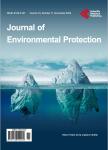Elemental Composition of PM<sub>2.5</sub>in Araraquara City (Southeast Brazil) during Seasons with and without Sugar Cane Burning
Elemental Composition of PM<sub>2.5</sub>in Araraquara City (Southeast Brazil) during Seasons with and without Sugar Cane Burning作者机构:Physic and Chemistry Institute Federal University of Itajubá (UNIFEI) Itajubá Brazil Environmental Engineering Department Federal University of Paraná (UFPR) Curitiba Brazil Institute for Environmental Assessment and Water Research (IDAEA-CSIC) Barcelona Spain Department of Pathology Faculty of Medicine University of Sao Paulo (USP) Sao Paulo Brazil Department of Chemistry University of Antwerp Antwerp Belgium Analytical Chemistry Department Institute of Chemistry Univ Estadual Paulista (Unesp) Araraquara Brazil
出 版 物:《Journal of Environmental Protection》 (环境保护(英文))
年 卷 期:2015年第6卷第5期
页 面:426-434页
学科分类:1002[医学-临床医学] 100214[医学-肿瘤学] 10[医学]
主 题:Sugar-Cane Burning PM2.5 Individual Particle Analysis EDXRF Cluster Analysis Principal Components Analysis
摘 要:Particulate matter with an aerodynamic diameter below 2.5 μm (PM2.5), present in polluted air, has been associated with a large spectrum of health impairments, mainly because of its deep deposition into the lungs. Araraquara City (Southeast Brazil) is surrounded by sugar-cane plantations, which are burned to facilitate the harvesting;this process causes environmental pollution due to the large amounts of soot that are released into the atmosphere. In this work, the elemental composition of PM2.5 was studied in two scenarios, namely in sugar-cane harvesting (HV) and in non-harvesting (NHV) seasons. The sampling strategy included one campaign in each season. PM2.5 was collected using a dichotomous sampler (10 L·min-1, 24 h) with PTFE filters. Information concerning the bulk elemental concentration was provided by energy-dispersive X-ray fluorescence. Enrichment factor analysis indicated that S, Cl, K, Cr, Ni, Cu, Zn, As, Cd and Pb were highly enriched relative to their crustal ratios (to Al). Principal component analysis was used to get some insight about the sources of the elements. Principal component 1 (PC1) explained 30.5% of data variance. The elements that had high loading (0.7) were: S, Cr, As, and Pb;these are associated with combustion of fossil fuels. In principal component 2 (PC2), Cl, Cu, Zn, and Cd showed high loadings;these elements are associated with biomass burning. The Ni concentration found is three times larger than the threshold of risk for lung cancer, as recommended by the World Health Organization.



